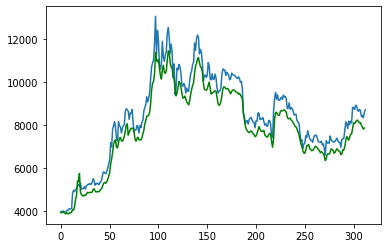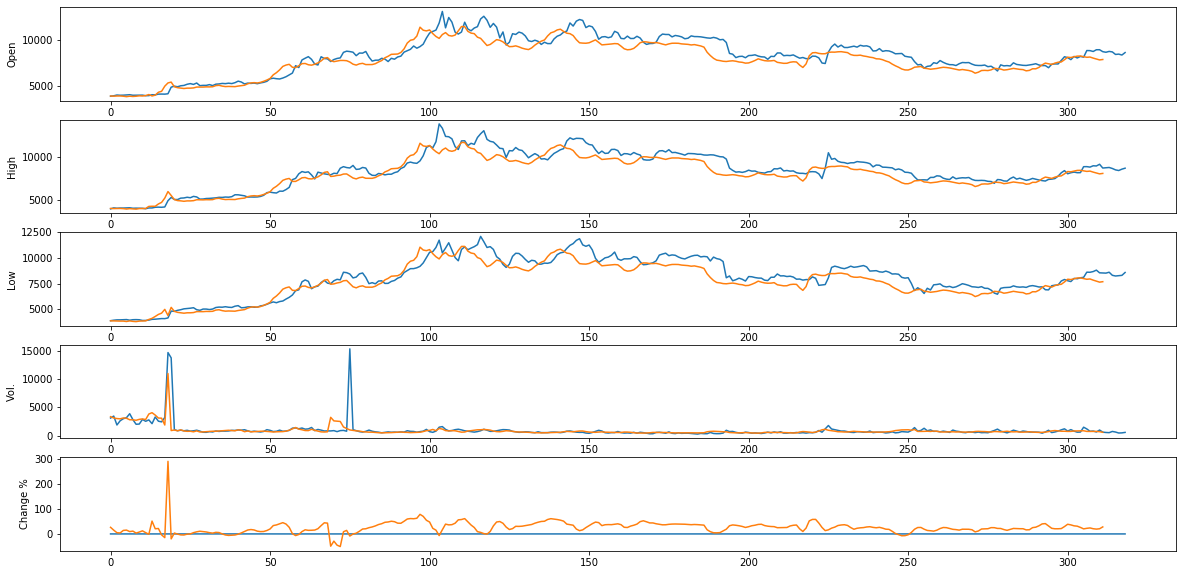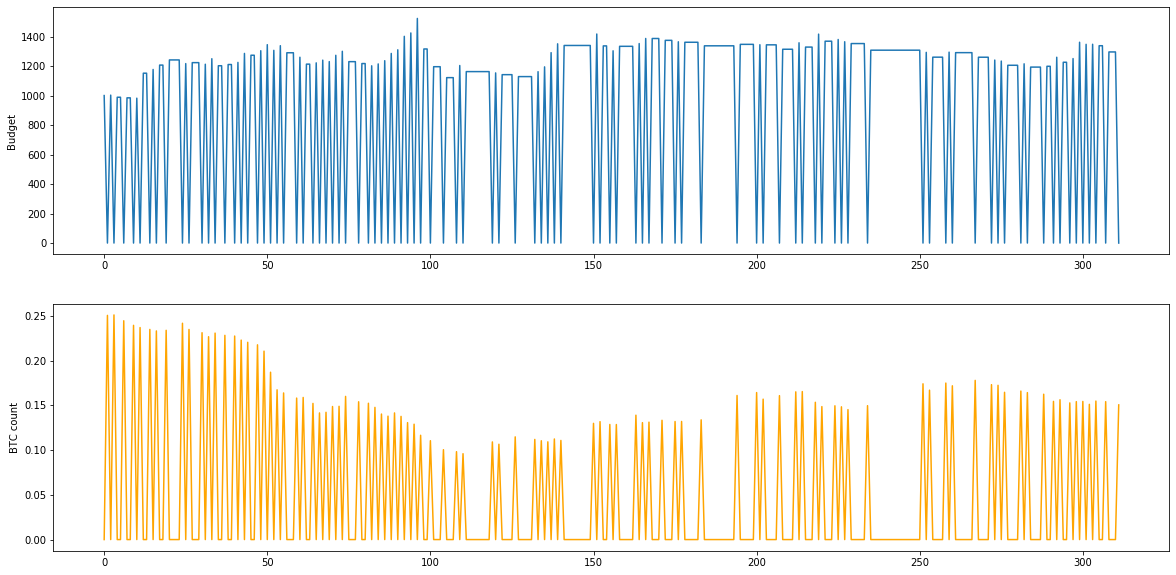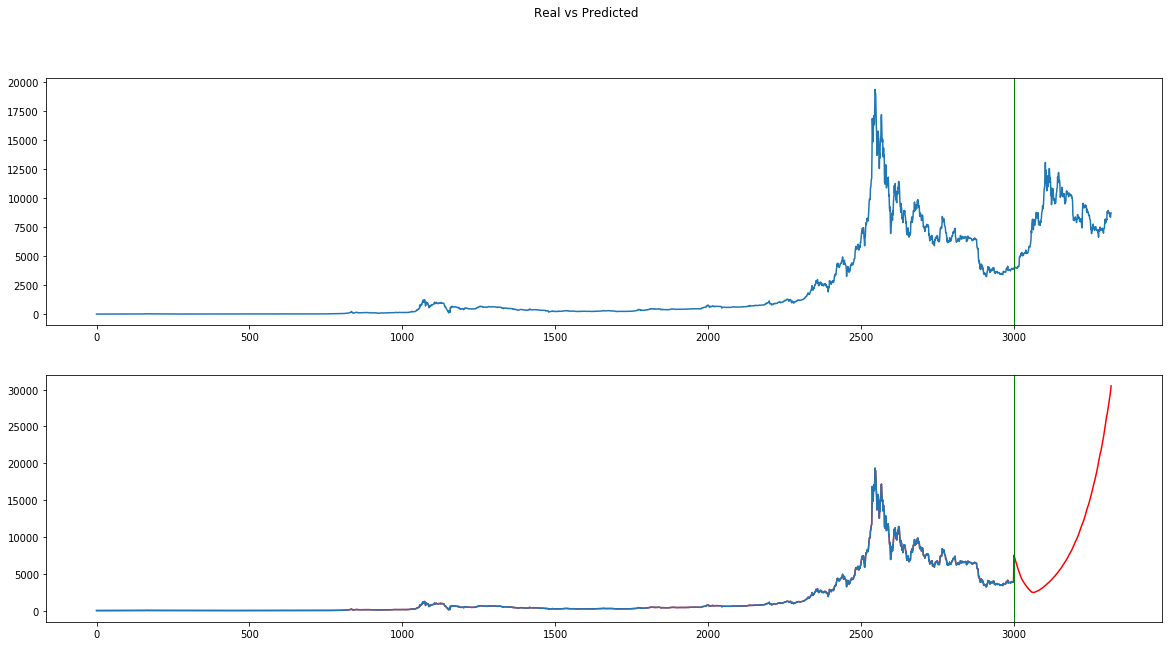How (not) to predict Bitcoin price (Ep. I)
Hi! In this new entry I wanted to show you a quick 24h project I was trying to carry to learn more about Recurrent Neural Networks implementations, specifically about Long-short Term Memories .
First of all, this must not be taken as financial advise, this is just an exercise to learn how to predict Multivariate Time Series with Deep Learning techniques. I have 0 knowledge on stock markets and how they work, and I just wanted to see if a blackbox algorithm like a neural network can make a newbie like me rich in a short period of time. Spoiler: it didn’t make me rich
Bitcoin is known to be a very complicated time series, with many external factors (even manipulation from some sectors and fake volumes by exchanges) and a huge variance (it can multiply its price by 2 in 24h). I have to say I expect nothing spectacular from this excercise, since it’s just a homemade solution in just one day with an old laptop which means I can’t test many models.
Let’s find out how I trained the net.
Data Preprocessing
First of all, we need to do a bit of preprocessing, since Change% is treated like a string and Volume is expressed in “Thousands” with a k at the end (4k = 4000, 4M=4000k). Therefore, we need to strip that last letter and convert both observations consequently.
Furthermore, there are a couple of observations with no volume. For those, i will asign the average of the two previous values as the filling one.
import pandas as pd
import numpy as np
data=pd.read_csv("bitcoinhist.csv",thousands=",")
data=data.iloc[::-1]
data=data.iloc[:,1:]
data=data.reset_index(drop=True)
data["Change %"]=[float(i.strip("%"))/100 for i in data["Change %"]]
volaux=np.zeros(len(data["Vol."]))
for k in range(len(data["Vol."])):
try:
obs=data.iloc[k,4]
multiplier=1
if obs[-1]=="M":
multiplier=1000
volaux[k]=float(obs[:-1])*multiplier
except:
volaux[k]=(volaux[k-1]+volaux[k-2])/2
data["Vol."]=volaux
data
| Price | Open | High | Low | Vol. | Change % | |
|---|---|---|---|---|---|---|
| 0 | 0.3 | 0.3 | 0.3 | 0.3 | 4.94 | 0.0000 |
| 1 | 0.3 | 0.3 | 0.3 | 0.3 | 15.44 | 0.0000 |
| 2 | 0.3 | 0.3 | 0.3 | 0.3 | 18.61 | 0.0000 |
| 3 | 0.3 | 0.3 | 0.3 | 0.3 | 2.54 | 0.0000 |
| 4 | 0.3 | 0.3 | 0.3 | 0.3 | 1.45 | 0.0000 |
| ... | ... | ... | ... | ... | ... | ... |
| 3314 | 8405.1 | 8678.5 | 8687.3 | 8309.6 | 722.67 | -0.0315 |
| 3315 | 8439.9 | 8404.9 | 8522.0 | 8242.6 | 617.02 | 0.0041 |
| 3316 | 8341.6 | 8439.9 | 8447.6 | 8277.2 | 444.00 | -0.0117 |
| 3317 | 8607.8 | 8341.6 | 8607.8 | 8304.9 | 468.34 | 0.0319 |
| 3318 | 8708.1 | 8608.1 | 8722.3 | 8585.6 | 554.32 | 0.0116 |
3319 rows × 6 columns
import numpy as np
import matplotlib.pyplot as plt
X=np.asarray(data)
X_train=X[0:3000,:]
X_test=X[3000:,:]
fig, axes = plt.subplots(6,figsize=(20,10))
for s in range(len(axes)):
axes[s].plot(X[:,s])
axes[s].set_ylabel(data.columns[s])
axes[s].plot(X_train[:,s])

I splitted my data in train and test, so I have some data that the net has never seen and would give me an accurate intuition of how it’s performing
TimeSeriesGenerator
Keras provides an utility for sequence segmentation. With TimeseriesGenerator we can just pass the series and tell it the length of the window (previous values) to predict the next ones.
The reason to ask for a 128 batch size is because powers of two are more computationally efficient, since computers memories are structured in bits/bytes
from keras.preprocessing.sequence import TimeseriesGenerator
window=7
series_train = TimeseriesGenerator(X_train, X_train, length=window, batch_size=128)
Model
I decided to go with this architecture after some trials, but in deep learning there is no solid guide to choose the architecture but trial and error.
Basically i stacked two layers of LSTM cells with Dropout (regularization technique that blocks some neurons while training randomly to avoid overfitting. This prevents that some neurons become so important that the rest won’t get to train). I used MAE as my loss function, since it’s a very popular metric in stock analysis
from keras.layers import LSTM,Dense,TimeDistributed,Dropout
from keras import Sequential
from keras.utils import plot_model
model = Sequential()
model.add(LSTM(200, activation='relu',return_sequences=True, input_shape=(window, X.shape[1])))
model.add(LSTM(100, activation='relu', return_sequences=False))
model.add(Dense(100, activation='relu'))
model.add(Dense(6))
model.compile(optimizer='adam', loss='mean_absolute_error')
It’s important to use fit_generator instead of fit when using generators.
model.fit_generator(series_train, steps_per_epoch=len(series_train),epochs=1000)
Epoch 1/1000
24/24 [==============================] - 1s 62ms/step - loss: 523.5249
...
Epoch 200/1000
24/24 [==============================] - 1s 34ms/step - loss: 112.3538
...
Epoch 300/1000
24/24 [==============================] - 1s 35ms/step - loss: 53.4992
...
Epoch 600/1000
24/24 [==============================] - 1s 34ms/step - loss: 124.4168
...
Epoch 1000/1000
24/24 [==============================] - 1s 35ms/step - loss: 191.3965
<keras.callbacks.callbacks.History at 0x7f5de85b9f98>
plt.plot(model.history.history["loss"])

The loss function seems to have decreased althought it’s kinda bad, it’s not a steady descent. Let’s see how it fits the time series in the train data
predicted_train=model.predict_generator(series_train)
price_pred_train=predicted_train[:,0]
price=X_train[:,0]
plt.plot(price)
plt.plot(price_pred_train)

Pretty good huh? However, such a good fitting could imply overfitting (we may have trained for too much epochs). Let’s use our test data to check if the fitting is that good in unseen data!
Time to go test
series_test = TimeseriesGenerator(X_test, X_test, length=window, batch_size=128)
predicted_test=model.predict_generator(series_test)
price_pred_test=predicted_test[:,0]
price_test=X_test[:,0]
plt.plot(price_test)
plt.plot(price_pred_test,color="g")
fig, axes = plt.subplots(5,figsize=(20,10))
for s in range(0,len(axes)):
axes[s].plot(X_test[:,s+1])
axes[s].set_ylabel(data.columns[s+1])
axes[s].plot(predicted_test[:,s+1])


Not a bad fit, specially for the price! We gonna be rich! Wait, there is something wrong with this. So easy, I created a really good predictor in my bedroom, why doesn’t everyone do this?
This results are a bit tricky. There is not much point in predicting to one day. Some Markovian models work like this (thanks to Alf from DataScienceSpain for the hints around this topic), as the best prediction for tomorrows value is todays value, which gathers a lot of information on the past days. Will I earn some money? Let’s make a simulation, starting with 1000$
budget=1000
btcs=0
predicted_price=price_pred_test
price_test=X_test[7:,0]
budget_hist=[budget]
btcs_hist=[btcs]
for tomorrow in range(1,X_test.shape[0]-window):
today=tomorrow-1
going_up=predicted_price[tomorrow]>predicted_price[today]
if going_up and budget>0: #If i predict the price is going up from todays and i have money, we buy some btc
btcs=budget/price_test[today]
budget=0
elif btcs>0: #we sell everything if it's gonna go down
#print("vendo")
budget=btcs*price_test[today]
btcs=0
budget_hist=budget_hist+[budget]
btcs_hist=btcs_hist+[btcs]
fig, (ax1,ax2) = plt.subplots(2,figsize=(20,10))
ax1.plot(budget_hist)
ax1.set_ylabel("Budget")
ax2.plot(btcs_hist,color="orange")
ax2.set_ylabel("BTC count")

print("Ended up with ",btcs_hist[-1]," bitcoins, which equals",btcs_hist[-1]*price_test[-1],"dollars")
print("Ended up with ",budget_hist[-1],"dollars")
Ended up with 0.15052999047914017 bitcoins, which equals 1310.8302100914007 dollars
Ended up with 0 dollars
In 300 days, my algorithm only made 310 dollars, which is not that amusing. My best mark was at past 100 days where I made roughly 500$, that means that I had a 1.31 \% profit in 300 days. Not that great, but okay for not having pressed a single key (although risking 1000 dollars)
Let’s make it harder, let’s predict based on past predictions
What happens if I trust my predictor to try to predict the next days? We will iterate feeding the last prediction as the input for the test data (suppose we don’t know the test data, that is yet to come in the future)
last_7pred=np.atleast_2d(predicted_test[-(window+1):,:])
future_predictions=[]
for day in range(X_test.shape[0]):
pred7_gen=TimeseriesGenerator(last_7pred,last_7pred,length=window,batch_size=1)
predicted_value=list(model.predict_generator(pred7_gen))
last_7pred=np.concatenate((last_7pred[1:,:],predicted_value))
future_predictions=future_predictions+predicted_value
Full series
full_pred=np.concatenate((X_train,future_predictions))
full_price=X[:,0]
fig, (ax1, ax2) = plt.subplots(2,figsize=(20,10))
fig.suptitle('Real vs Predicted')
ax1.plot(X[:,0])
ax2.plot(full_pred[:,0],color="red")
ax2.plot(X_train[:,0])
ax1.axvline(x=3000, linewidth=1, color='g')
ax2.axvline(x=3000, linewidth=1, color='g')
<matplotlib.lines.Line2D at 0x7f5de0473c88>

That’s the problem I was referring to earlier. My net has learnt that if the price arose in the past 7 days, it should go upwards. Therefore, if the first 7 predictions are upwards, this will feedback the net making the price prediction explode (according to my net, by 27th of January 1 BTC would cost 20 million dollars, pretty inaccurate I’d say)
Final Thoughts
As I said, this was not a financial investment exercise, but more of a basic LSTM introduction. Although the fit on test is not bad, we can see that Bitcoin price is not such an easy time series to predict with unknown data.
We could try different architectures or use some finantial indicators as input variables. Maybe incorporate some new information or just use present data, since btc has evolved a lot since the old times.
Another good idea from statistical time series models such as ARIMAs (which I do know of from my university lessons but haven’t tried for bitcoin) is to make the time series stationary (no trend and homogeneous variance).
Maybe I make a series out of this experience trying to improve my model and learn new things about forecasting time series. You can find the code & data under this repository in a Jupyter Notebook.
Thanks for reading!
